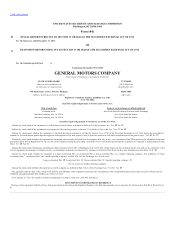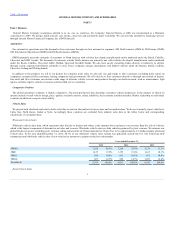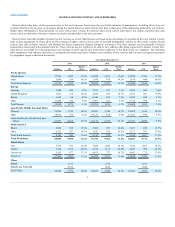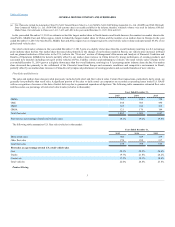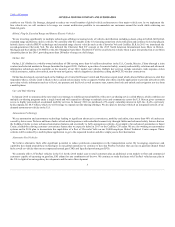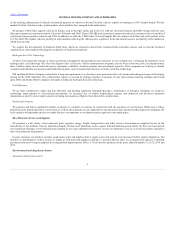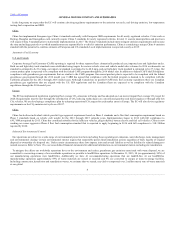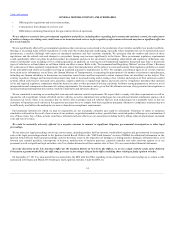General Motors 2015 Annual Report Download - page 10
Download and view the complete annual report
Please find page 10 of the 2015 General Motors annual report below. You can navigate through the pages in the report by either clicking on the pages listed below, or by using the keyword search tool below to find specific information within the annual report.
Table of Contents
We are subject to laws and regulations that require us to control automotive emissions, including vehicle exhaust emission standards, vehicle evaporative
emission standards and onboard diagnostic (OBD) system requirements. Advanced OBD systems are used to identify and diagnose problems with emission
control systems. Problems detected by the OBD system and in-use compliance monitoring may increase warranty costs and the likelihood of recall. Emission
and OBD requirements become more stringent each year as vehicles must meet lower emission standards and new diagnostics are required throughout the
world without harmonization of global regulations. Zero emission vehicle (ZEV) requirements have been adopted by some U.S. states and there is the
possibility that additional jurisdictions could adopt ZEV requirements in the future. While we believe all our products are designed and manufactured in
material compliance with vehicle emissions requirements, regulatory authorities may conduct ongoing evaluations of the emissions compliance of products
from all manufacturers. This includes vehicle emissions testing, including CO2 and nitrogen oxide emissions testing in Europe, and review of emission
control strategies.
U.S. and Canada
The U.S. federal government imposes stringent emission control requirements on vehicles sold in the U.S. and additional requirements are imposed by
various state governments. Canada’s federal government vehicle emission requirements are generally aligned with the U.S. federal requirements. Each model
year we must obtain certification for each test group that our vehicles will meet emission requirements from the U.S. Environmental Protection Agency (EPA)
before we can sell vehicles in the U.S. and Canada and from the California Air Resources Board (CARB) before we can sell vehicles in California and other
states that have adopted the California emissions requirements.
CARB's latest emission requirements include more stringent exhaust emission and evaporative emission standards including an increase in ZEVs offered
by the same automaker such as electric and hydrogen fuel cell vehicles. CARB has adopted 2018 model year and later requirements for increasing volumes of
ZEVs to achieve greenhouse gas as well as criteria pollutant emission reductions to help achieve the state's long-term greenhouse gas reduction goals. The
EPA has adopted similar exhaust emission and evaporative emission standards which phase in with the 2017 model year, but do not include ZEV
requirements. These new requirements will also increase the time and mileage periods over which manufacturers are responsible for a vehicle's emission
performance.
The Clean Air Act permits states that have areas with air quality compliance issues to adopt the California car and light-duty truck emission standards in
lieu of the federal requirements. Thirteen states currently have these standards in effect and 10 of these 13 states have adopted the ZEV requirements. The
Province of Quebec has also announced its intention to adopt a ZEV requirement.
European Union
Emissions are regulated by the European Commission (EC) and by governmental authorities in each European Union Member State (EU Member States).
The EC imposes emission control requirements on vehicles sold in all 28 EU Member States. We must demonstrate that vehicles will meet emission
requirements from an approval authority in one EU Member State before we can sell vehicles in any EU Member States. The regulatory requirements include
random testing of newly assembled vehicles and a manufacturer in-use surveillance program. The European Union requirements are equivalent in terms of
stringency and implementation to the framework of the United Nations Economic Commission for Europe.
The existing level of exhaust emission standards for cars and light-duty trucks, Euro 6, was effective in 2014 for new vehicle approvals and 2015 for new
vehicle registrations. Future European Union emission standards focus particularly on further reducing emissions from diesel vehicles by introducing new
testing criteria based on “real world driving” emissions (RDE). RDE tests will become effective in 2017. The new requirements will require additional
technologies and further increase the cost of diesel engines, which currently cost more than gasoline engines. To comply with RDE tests we expect that we
will need to implement technologies identical to those already in production to meet U.S. emission standards. These technologies will put additional cost
pressures on the already challenging European Union market for small and mid-size diesel vehicles. Gasoline engines are also affected by the new
requirements. The measures for gasoline vehicles that require technology to reduce exhaust pollutant emissions will have adverse effects on vehicle fuel
economy which drives additional technology cost to maintain fuel economy.
In addition, increased scrutiny of compliance with emissions standards following the well-publicized emissions scandal involving an unrelated automotive
manufacturer may result in changes to these standards, including the implementation of RDE tests, as well as stricter interpretations of these standards and
more rigorous enforcement. This may lead to increased costs, penalties, negative publicity or reputation impact for us. Refer to Item 1A. Risk Factors for
further discussion of these risks.
7

